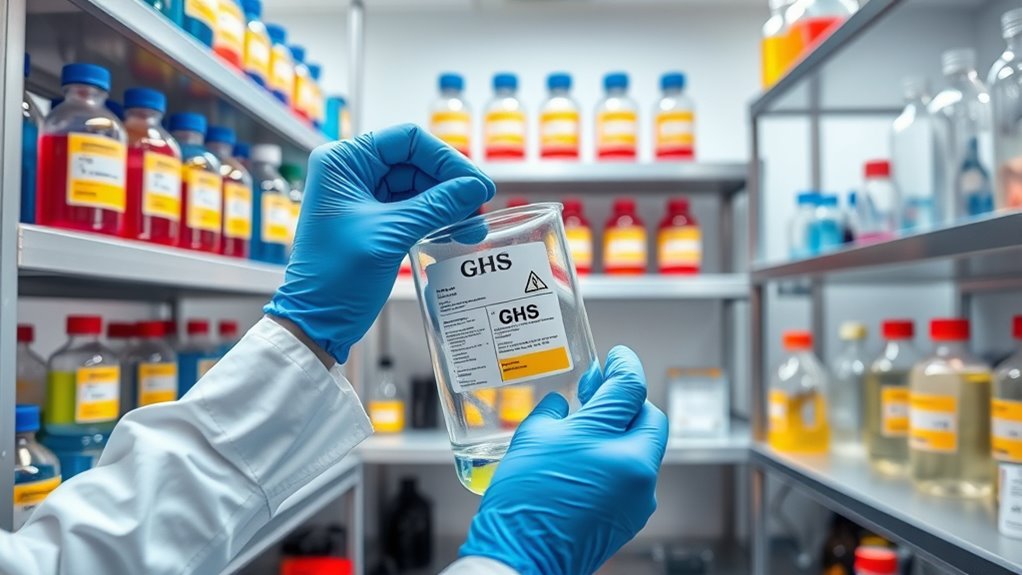To implement GHS labels in your small-scale lab, start by evaluating your current labeling practices for clarity and consistency. Gather affordable, durable labels designed to support GHS symbols and hazard information. Keep labels simple, with essential details and visual cues to improve recognition. Train staff on GHS standards and establish regular inspection routines. For effective, compliant labeling methods and tips on overcoming common challenges, continue exploring these strategies to make certain of safety and regulatory adherence.
Key Takeaways
- Assess existing labels for clarity, consistency, and compliance with GHS requirements before redesigning or replacing them.
- Select durable, compatible label materials and software that support GHS symbols, hazard statements, and color coding.
- Design labels with clear hazard icons, minimal text, and standardized layouts for quick hazard recognition.
- Implement routine inspection and maintenance schedules to ensure label visibility and integrity over time.
- Provide comprehensive staff training on GHS symbols, hazard communication, and proper label application and interpretation.
Understanding the Importance of GHS Labeling in Small Labs
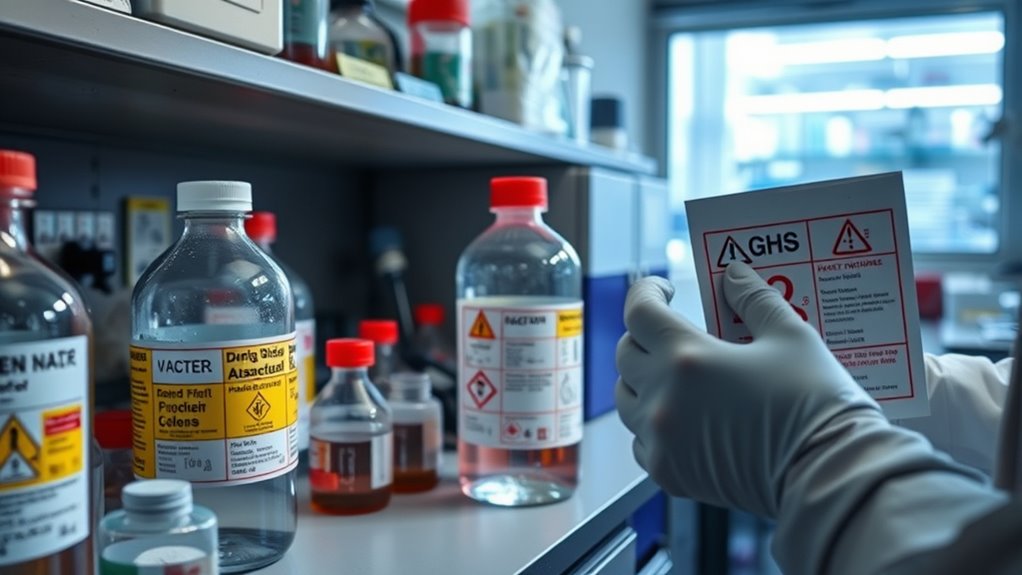
While small labs may seem less prone to hazards, understanding the importance of GHS labeling is crucial for safety. Proper labels improve chemical storage by clearly indicating hazards, reducing accidental exposures. GHS labels facilitate hazard communication, ensuring everyone in the lab recognizes risks associated with chemicals. Even in smaller settings, misidentification can lead to dangerous situations, from spills to improper handling. Clear labeling helps you quickly identify chemical hazards, enabling you to take appropriate precautions. It also assists in emergency responses, guiding first aid and cleanup efforts. Implementing GHS labels isn’t just about compliance; it’s about creating a safer environment. Accurate hazard communication through labeling protects you, your colleagues, and the integrity of your work, regardless of the lab’s size. Additionally, understanding chemical hazard communication enhances overall safety practices in your lab environment. Properly applying visual indicators like labels ensures hazards are immediately recognizable, further reducing risks. Utilizing GHS standards ensures consistency and clarity in hazard information, which is vital for effective safety management.
Assessing Your Laboratory’s Current Labeling Practices
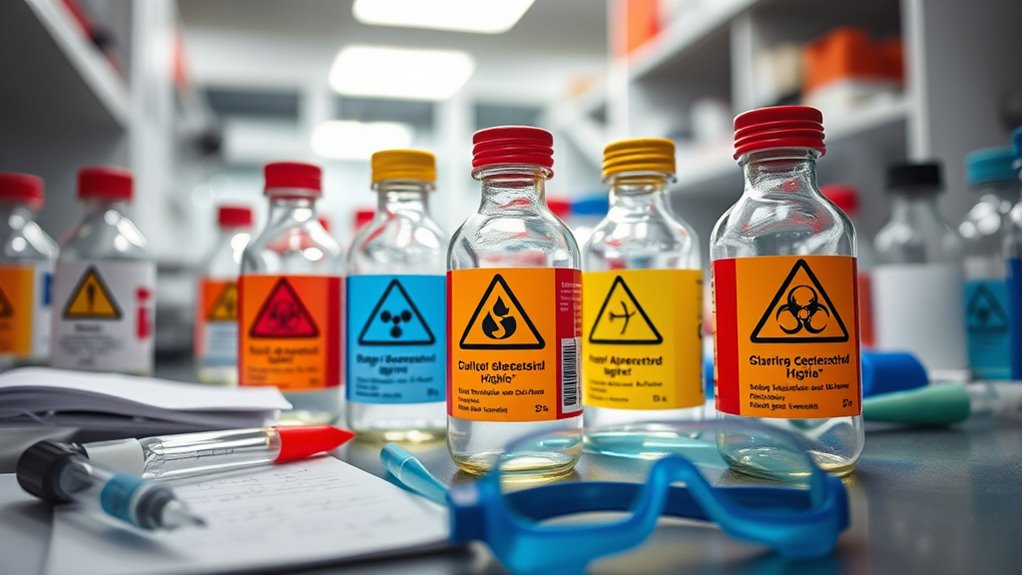
Have you ever evaluated how effectively your lab’s current labeling practices communicate chemical hazards? Conducting this assessment helps identify gaps and opportunities for improvement. Review your existing labels’ clarity and consistency, considering if hazard symbols, ingredient information, and safety instructions are easily understood. Check if your labeling software supports GHS standards and allows for quick updates. Evaluate your label printing process—are labels durable, legible, and resistant to lab conditions? Ask whether your team follows a standardized approach or relies on inconsistent methods. This review ensures that labels meet safety requirements and facilitate hazard recognition. Additionally, assessing your lab’s adherence to environmental considerations can help minimize ecological impact and promote sustainable practices. Incorporating vibrational alignment techniques from the Law of Attraction can also support a more positive and proactive safety culture within your lab. Emphasizing the importance of resources and tools can enhance your labeling practices by providing access to the latest standards and technological support. By understanding your current practices, you can plan targeted improvements to align with GHS standards and streamline your labeling workflow effectively.
Gathering Necessary GHS Labeling Materials and Resources
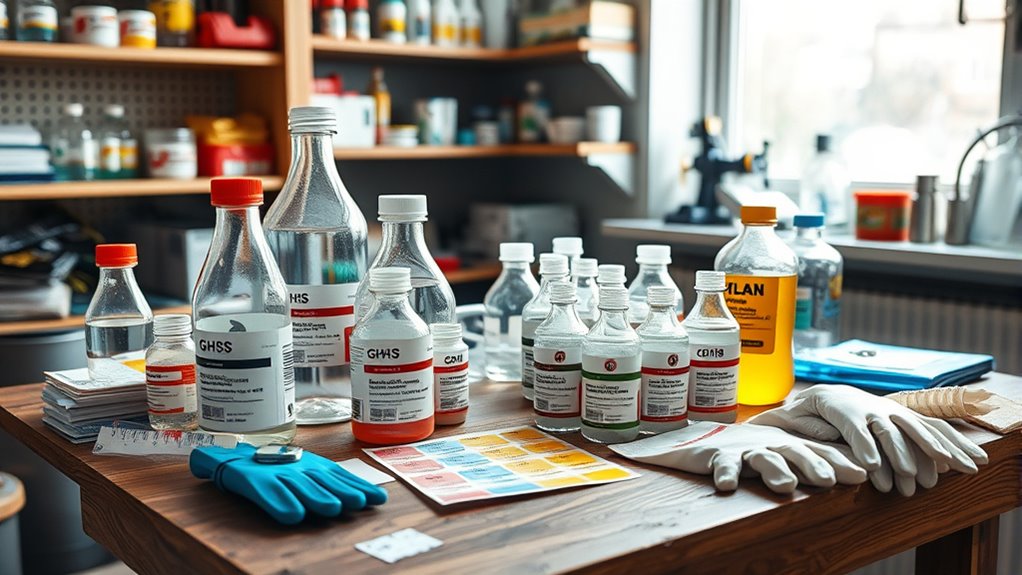
To effectively implement GHS labels, you need to gather all the necessary materials and resources upfront. Start by selecting reliable labeling software that allows you to create accurate, compliant labels quickly. Facilitate the software supports GHS symbols, hazard statements, and other required information. Next, acquire blank labels suitable for your lab’s containers and equipment, choosing durable options that withstand chemical exposure. Consider printing supplies like ink or toner compatible with your printer type. If you plan to produce custom labels, secure design templates or labels with pre-printed elements to streamline the process. Having these materials ready assures you can efficiently produce clear, compliant GHS labels, reducing delays and errors. Proper preparation sets a solid foundation for a smooth labeling transition in your lab. Additionally, understanding Kia Tuning can help you customize and optimize equipment or tools used in your lab to better suit specific safety or operational needs.
Simplifying Label Design and Content for Small-Scale Operations
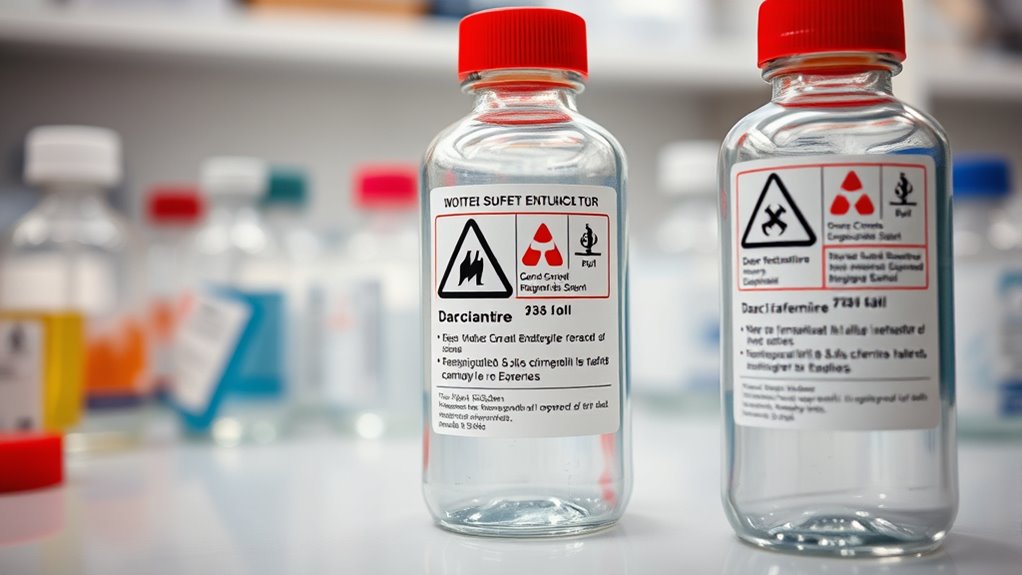
Once you’ve gathered your materials and set up your labeling process, simplifying the design and content of your GHS labels can guarantee time savings and reduce errors. Focus on using simplified iconography to clearly convey hazards without clutter. Keep your wording concise—avoid unnecessary details and stick to essential information. This approach helps ensure labels are easy to read and understand quickly, especially in small-scale labs with limited resources. To make your labels effective, consider these tips:
Simplify GHS labels with clear icons and concise text for quick, error-free communication.
- Use clear, recognizable symbols to communicate hazards instantly
- Limit text to key information like chemical name, hazard class, and handling instructions
- Keep layout clean and consistent to avoid confusion
- Implement effective communication techniques to enhance label clarity and safety, such as using standardized formats aligned with hazard communication standards. Incorporating visual communication principles can further improve the effectiveness of your labels by making critical information more accessible.
Implementing Cost-Effective Labeling Strategies
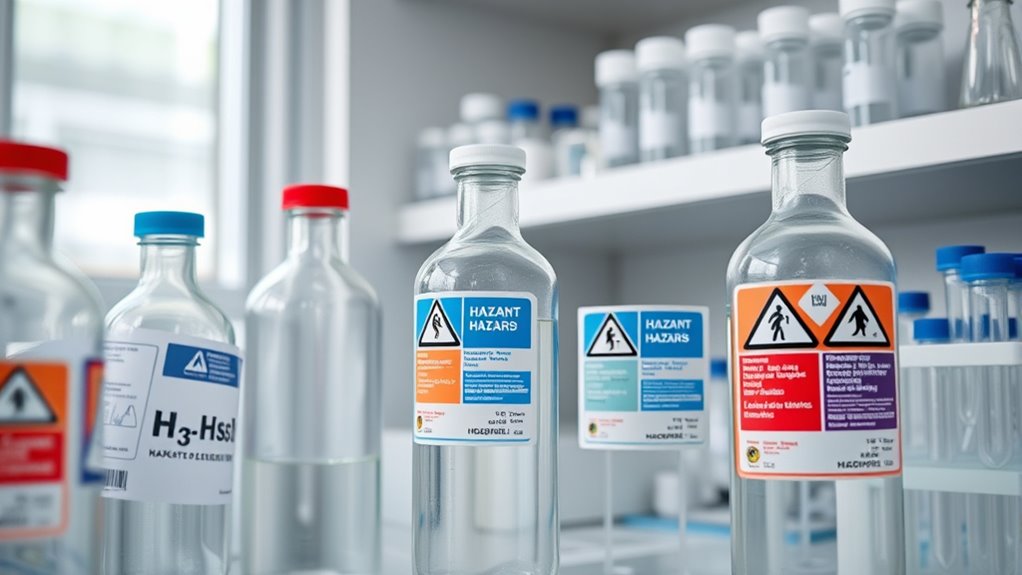
To save costs, you should choose affordable label materials that still meet safety standards. Efficient label application methods can also reduce time and labor expenses. Additionally, understanding keto-friendly ingredients can help you select labels that highlight low-carb and high-fat options effectively. For example, selecting labels that are compatible with various surfaces can streamline the process across different lab setups. Being aware of GHS labeling requirements ensures compliance and safety while minimizing unnecessary expenses. By combining these strategies, you can implement GHS labels without overspending.
Affordable Label Materials
Choosing the right label materials can considerably reduce your overall compliance costs while maintaining safety standards. Affordable options don’t mean sacrificing label durability or effective color coding. Look for materials like polyester or polypropylene labels, which resist chemicals and moisture, ensuring labels stay intact over time. Consider self-adhesive labels that are easy to apply and remove if needed. Using color-coded labels also helps quickly identify hazards, saving time and reducing errors during inspections. Investing in versatile, budget-friendly materials ensures your labels remain legible and durable, even with frequent handling. Proper label selection can significantly impact the longevity and clarity of your safety labels, helping you maintain compliance efficiently. Additionally, selecting labels with chemical resistance ensures they withstand exposure to various substances commonly found in laboratories. Incorporating automated labeling solutions can further streamline the process and reduce manual errors, enhancing overall lab safety and efficiency.
Efficient Label Application
Efficient label application is key to maintaining compliance without wasting time or resources. To streamline this process, focus on digital labeling tools that enable quick, accurate label customization. Digital labeling allows you to create consistent, clear labels tailored to your specific needs, reducing errors and rework. Using label customization options, you can incorporate necessary GHS symbols, hazard statements, and other information seamlessly. Automating label printing with digital systems saves you time and minimizes material waste. Additionally, pre-designed templates ensure uniformity across labels, making your labeling process more efficient. By adopting digital labeling strategies, you can implement GHS labels more effectively, ensuring safety and compliance without compromising productivity or incurring unnecessary costs. Incorporating site navigation into your digital labeling system can further improve workflow management and access to labeling resources. Leveraging hybrid systems can also enhance the versatility and adaptability of your labeling process across different environments and requirements. Incorporating automated workflows can further reduce manual errors and increase overall efficiency in your labeling procedures.
Training Staff on GHS Label Requirements and Safety Protocols

Training staff on GHS label requirements and safety protocols is essential for ensuring that everyone understands how to interpret labels correctly and respond appropriately to hazards. Proper staff training helps prevent accidents and ensures consistent safety practices. Use hands-on sessions with labeling software to familiarize staff with label creation and recognition. Reinforce understanding of GHS symbols, signal words, and hazard statements through real-world examples. Regular training updates keep everyone informed about new guidelines or label changes. Consider incorporating visual aids and quick-reference guides to enhance learning and recall. Remember, well-trained staff can identify hazards swiftly, reducing risks and ensuring compliance. Additionally, incorporating diverse training methods like interactive workshops can improve retention and engagement. Incorporating case studies of real incidents can further enhance understanding of potential workplace hazards. To ensure that staff can accurately identify and interpret the various GHS symbols, comprehensive visual aids should be integrated into training sessions. By investing in effective staff training, you foster a safer lab environment where GHS labels are accurately understood and applied.
Establishing a Routine for Label Inspection and Maintenance
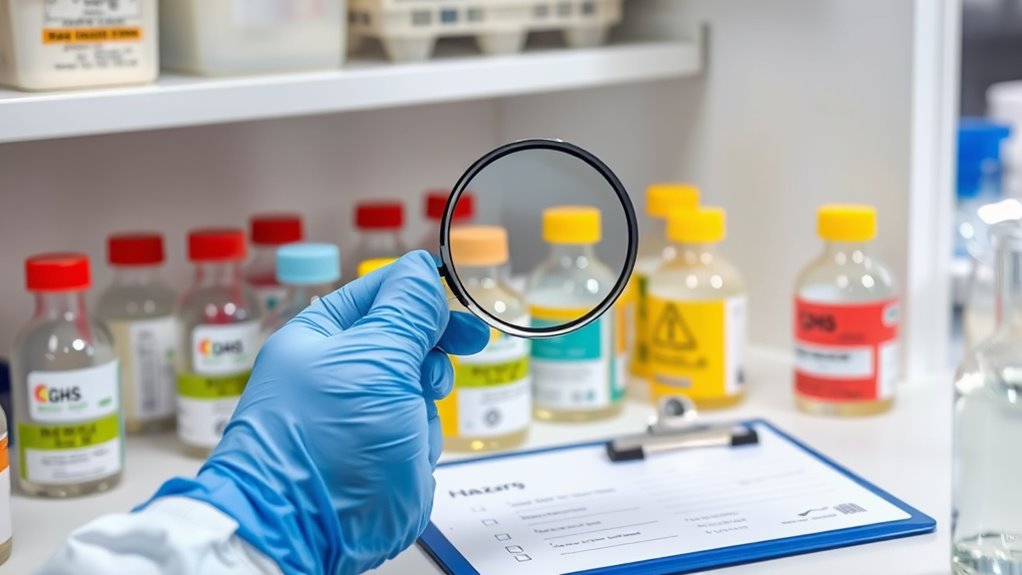
You need a regular inspection schedule to guarantee labels stay clear and intact. Establishing clear maintenance procedures helps you quickly address any damage or fading. Consistent checks keep your labeling reliable and compliant with safety standards. Additionally, training staff to recognize signs of spoilage can prevent the use of compromised labels and ensure safety.
Regular Inspection Schedule
To guarantee GHS labels remain effective and compliant, establishing a regular inspection schedule is essential. Consistent checks help monitor label durability and ensure labels stay legible and intact. By setting a defined inspection frequency, you can catch issues early, such as fading, peeling, or damage that might compromise safety. Regular inspections prevent mislabeling risks and maintain compliance with safety standards.
Consider these points:
- Schedule inspections weekly or biweekly based on chemical exposure and storage conditions
- Check for fading, peeling, or dirt that could obscure the information
- Replace damaged or worn labels immediately to maintain clarity and durability
Implementing these practices keeps your labels effective, reduces hazards, and maintains a safe lab environment.
Label Maintenance Procedures
Establishing a routine for label inspection and maintenance is vital to guarantee ongoing safety and compliance in the workplace. Regular checks ensure labels maintain their durability, preventing peeling, fading, or damage that could obscure critical information. You should verify that labels are securely affixed and that the ink remains legible. Using ink compatible with your labels and environment helps prevent smudging or deterioration over time. If you notice any signs of wear or damage, replace or update the labels promptly. Consistent inspection minimizes risks associated with mislabeled chemicals and maintains compliance with GHS standards. Establishing this routine ensures that labels continue to serve their purpose effectively, supporting a safe and organized laboratory environment.
Troubleshooting Common Challenges During Implementation

Implementing GHS labels can present several common challenges, especially when organizations encounter unfamiliarity with the system or face logistical hurdles. One major issue is selecting the right labeling software that integrates smoothly with your existing chemical storage processes. You might also struggle with inconsistent labeling practices across different storage areas, leading to confusion or errors. Additionally, resource constraints can delay the implementation, especially in small-scale labs with limited staff. To troubleshoot, consider these tips:
- Confirm your labeling software is user-friendly and compatible with your chemical storage setup.
- Standardize labeling procedures across all storage areas to maintain consistency.
- Allocate time and resources for staff training to build familiarity with GHS requirements.
Addressing these challenges early helps streamline the transition and improves overall safety.
Maintaining Compliance and Staying Updated With GHS Regulations
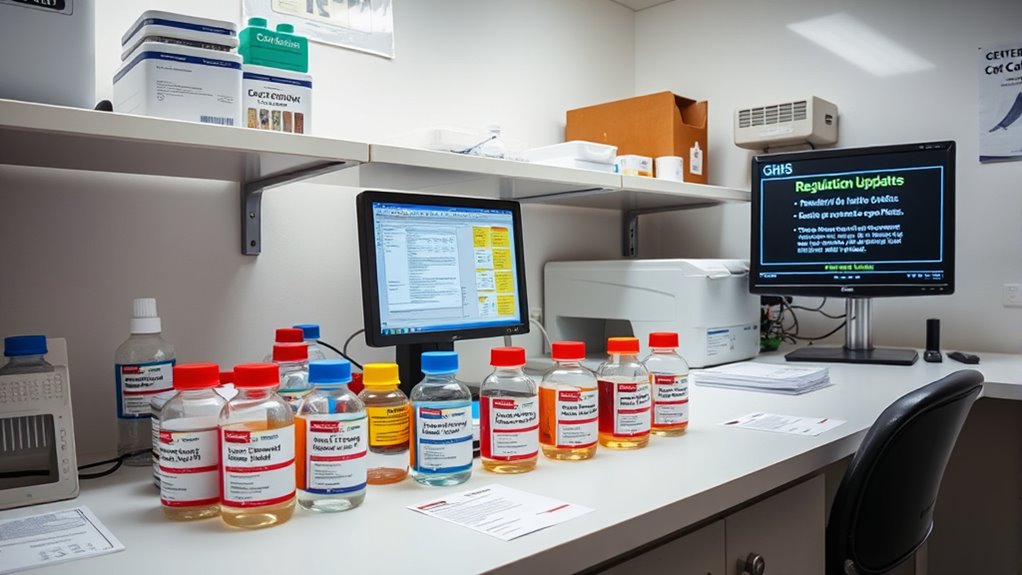
Staying compliant with GHS regulations requires ongoing effort, as these standards evolve to reflect new scientific knowledge and safety practices. To maintain chemical safety, you need to regularly review regulatory updates and adjust your labeling procedures accordingly. This means staying informed about changes from authorities like OSHA or OSHA-approved agencies, which often release updates on classification criteria and label requirements. Implement a system to monitor these updates and train your team promptly. Regular audits help identify gaps in compliance, ensuring your lab remains aligned with current standards. By actively managing regulatory updates, you protect your staff and environment, reduce liability, and ensure your labeling remains effective and compliant over time. Staying proactive is key to ongoing chemical safety and regulatory adherence.
Frequently Asked Questions
How Can Small Labs Automate GHS Labeling Processes Effectively?
You can automate GHS labeling in small labs by using digital label printers linked to your chemical storage management system. This setup guarantees labels are generated automatically whenever chemicals are added, reducing manual errors. It helps maintain safety compliance by ensuring accurate, legible labels. Regularly updating your software and training staff on the system’s use will streamline the process, improving safety and efficiency in managing hazardous materials.
What Are the Best Practices for Labeling Chemicals With Limited Space?
When labeling chemicals with limited space, you should prioritize clear, concise information. Use labeling color coding to quickly identify hazards and guarantee labels are durable enough to withstand handling and environmental conditions. Keep labels simple yet informative, focusing on essential details like chemical name, hazard symbols, and precautionary statements. Regularly check label integrity, replacing any that become illegible or damaged, to maintain safety and compliance in your lab.
How Do I Handle Labeling for Hazardous Waste Disposal?
When handling hazardous waste disposal labeling, you should focus on waste segregation and label durability. Clearly mark each waste container with relevant hazard information, guaranteeing labels are durable enough to withstand disposal conditions. Proper waste segregation prevents mixing incompatible chemicals, reducing hazards. Always follow local regulations, update labels as needed, and ensure labels remain legible throughout the waste’s storage and disposal process. This approach keeps everyone safe and compliant.
Are There Digital Tools to Assist in GHS Label Management?
Imagine you’re managing lab labels efficiently with digital tools. You can use digital label printers that connect to inventory management software, streamlining GHS label creation and tracking. For example, a small lab reduced errors and saved time by integrating these tools, ensuring accurate hazard communication. These digital solutions help you organize your labels, maintain compliance, and quickly update information, making GHS label management straightforward and reliable.
How Can Small Labs Ensure Consistent Labeling During Staff Changes?
To guarantee consistent labeling during staff changes, you should focus on maintaining training consistency and thorough staff training. Develop standardized procedures and clear documentation for GHS labels, so new team members can easily follow them. Regularly update training materials and provide hands-on practice. This way, everyone understands the labeling requirements, reducing errors and ensuring compliance, regardless of staff turnover.
Conclusion
Implementing GHS labels in your small lab is vital for safety and compliance. Did you know that proper labeling can reduce chemical-related incidents by up to 50%? By evaluating your practices, simplifying designs, and training your staff, you’ll create a safer, more organized environment. Staying proactive with routine inspections and updates ensures ongoing compliance. Take these steps today to protect your team and meet regulatory standards effectively.
